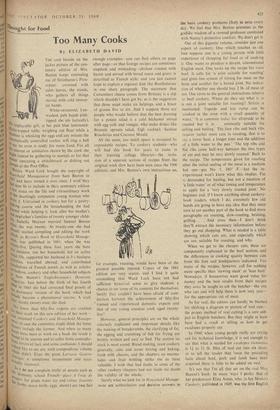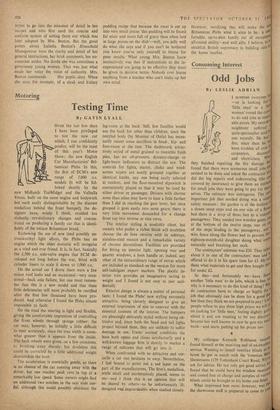t hought for Food
Too Many Cooks
By ELIZABETH DAVID
THE cool blonde on the jacket picture of the cen- tenary edition of Mrs. Beeton keeps reminding me of Swinburne's Pros- crpi ne : crowned with calm leaves, she stands, who gathers all things mortal with cold immor- tal hands.
White-sweatered, Lux- washed, pale hands pink- tipped she sits (actually), hih,Is implacable girl, at her pale bide laminated- '24k-topped table, weighing out flour while a machine is whisking the eggs and any minute the 4tItotnatically tontrolled cooker will ring a bell SaY its oven is ready for more food. For all II interest .or animation shown by the cook she h ,. matter indeed be gathering in mortals or for that 'atter operating a switchboard or dishing out taIllPs at the Post Office. tiMessrs. Ward Lock bought the copyright of :"Arhold Management from Sam Becton in 1147 and have owned it ever since. I wish they 1 seen fit to include in their centenary edition ifew notes on the life and extraordinary work w the dazzlingly competent young woman who rote it. Untrained in cookery but for a pastry- s and the housekeeping she had Darned while helping tc look after her mother's :4I stepfather's families of twenty younger child- wQ,11' Isabella Mayson married Samuel Becton igen she was twenty. At twenty-one she had ',,li,readY started compiling and editing the work 4'01. Beeton's ?look of Household Manage- ,1::'11. Was published in 1861, when 'she was lentY-five, During these four years she bore " children, ran her household, led an active life, supported her husband in h's business IL-IIvies, travelled abroad, ad ontributed r`Inslitations of French novels asn wellc as articles 1:11 fashion, cookery and other household subjects 1"1 Sam Becton's Englishwoman's Domestic hr.'Ruz.bre. Just before the birth of her fourth IhIld in 1865 she had corrected final proofs of dictionary version of the hook which had 1.1:tatlY become a phenomenal success. A week 'el'• barely twenty-nine, she died. r,!\1, 0 fewer than fifty-five experts arc credited tl I their work on this new edition of her work-- (14 renamed Cookery and thmsehoid Manage- 4d P01, in case the customers might think the latter include the former. And when so many 11'tnds have been at work on a book the result is giro's to be uneven and to suffer frcim contradic- tinns, errors of fact, and some confusion. I should ildeed like to see any such compendious volume didn't. Even the great Larousse Gastro- is sometimes inconsistent and occa- "ally incorrect. S' I do not complain really of details such as the domestic school French—Owe d recur de fo"Pl'e.s for grae watr ice and erc'que /or/entre r frothy saucep (milk,e eggs, shcrry) are two fair enough examples—you can find others on page after page—or that foreign recipes are sometimes slapdash and misleading—chicken roasted with bacon and served with bread sauce and gravy is described as French style; and you just cannot hope to explain a regional dish like Bouillabaisse in one short paragraph. The statement that Camembert cheese comes from Brittany is a slip which shouldn't have got by, as is the suggestion that three snipe make six helpings, and a brace of grouse five or six. And I suppose there are people who would believe that the best dressing for a potato salad is a cold béchamel mixed with egg yolk and vinegar, who make dishes like Brussels sprouts. salad, Ugli cocktail, Sardine Rissolettes and Coconut Mould.
All the same, too mush space is occupied by expendable recipes. To cookery students-- who will find this book for years to come in their training college libraries—the inclu- sion of a separate section of recipes from the original work (few have been seen since the 1906 edition), and Mrs. Beeton's own instructions on, for example, roasting, would have been of the greatest possible interest. Copies of the 1861 edition are very scarce, and I find it quite astonishing that Ward Lock have not had sufficient historical sense to give students a chance to sec some of its contents for themselves. Surely they couldn't have been afraid of com- parison between the achievement of fifty-five trained and experienced domestic experts and that of one young amateur cook aged twenty- live?
However, general principles are on the whole concisely explained and important details like the making of breadcrumbs, the clarifying of fat, the egging and crumbing of fish for frying are briskly written and easy to find. The section on stock is most sound. Bread making, yeast cookery • generally, cake and scone mixing and baking, fresh milk cheeSes, and the chapters on marma- lades and fruit bottling strike me as most valuable. I wish that bad faults in some of the other cookery chapters had not made me doubt the validity of the whole.
Surely what we look for in Household. Manage- ment are authoritative and decisive answers to the basic cookery problems likely to arise every day. We feel that Mrs. Beeton promises us the godlike wisdom of a revered professor combined with Nanny's protective comfort. We don't get it.
Out of this gigantic volume, consider just one aspect of cookery. One which touches us all. Just suppose one is a young person with little experience of shopping for food or of cooking it One wants to produce a decent, conventional English meal. One looks up the recipe for roast beef. It calls for 'a joint suitable for roasting' and gives one system of timing for meat on the bone and another for a boned joint. No indica- tion of whether one should .buy 2 lb. of meat or ten. One turns to the general instructions relative to beef cookery. Where do they say what is or is not a joint suitable for roasting? Sirloin is mentioned. Topside and top rump can be 'cooked in the oven with a small quantity of water,' it is common today for silverside to be roasted but it is . . eminently suitable for salting and boiling.' The fore ribs and back ribs require 'rather more care in roasting, that is to say a lower heat, a longer time and the addition of a little water to the pan.' The top ribs and flat ribs come half-way between the 'two types Of cut and may be very slowly roasted.' Back to the recipe. The temperature given for roasting after the initial sealing of the meat is a medium hot one—gas No. 5, 380° F.—but the in- experienced won't know what this implies. Fat is demanded for basting, but not a mention of 'a little water' or of what timing and temperature to apply for a 'very slowly roasted joint.' No beginner and, if I know anything about cookery- book readers, which I do, extremely few old hands are going to have any idea that they must turn to yet another part of the book to find more paragraphs on roasting, slow-roasting, braising, grilling. . . And even then-1 don't think they'll extract the necessary information before they go out shopping. What is needed is a table showing which cuts are, and especially which are not, suitable for roasting, and why.
When we get to the cheaper cuts, these arc competently explained in the beef section, and the differences in cooking quality between cuts from the fore and hindquarters indicated. Too many of the recipes, however, call for nothing more specific than 'stewing steak' or 'lean beef.' Nowadays, if housewives want good value for money and the best results from their recipes they must be taught to ask the butcher—the one who can and will help them is now very rare-- for the appropriate cut of meat.
As for veal, the editors can hardly be blamed for shirking a diagram or picture of veal cuts- - the proper method of veal cutting is a sore sub- ject to English butchers. But they might at least have had a crack at telling us how to get escalopes properly cut.
In 1960, when young people really are crying out for technical knowledge, it is not enough to say that what is needed for escalopes viennoises is 13- to 11 lb. fillet of veal cut into six slices, or to tell the reader that 'once the preceding facts about beef, pork and lamb have been acquired there is little to be added on veal.'
It's not that I'm all that set on the real Mrs. Becton's book. In many ways I prefer that of her predecessor Eliza Acton, who, in her Modern Cookers', published in 1845, was the first English writer to go into the minutest of detail in her recipes and who first used the concise and uniform system of setting them out which was later adapted by Mrs. Beeton. But the great points about Isabella Beeton's Household Management were the clarity and detail of her general instructions, her brisk comments, her no- nonsense asides. No doubt she was sometimes a governessy young woman. That was just what made her voice the voice of authority. Mrs. Beeton commands... Her pupils obey. When she says, for example, of a steak and kidney pudding recipe that because the meat is cut up into very small pieces 'this pudding will be found far nicer and more full of gravy than when laid in large pieces. on the dish'—well, you jolly well do what she says and if you can't be bothered you know you've only yourself to blame for poor results. What young Mrs. Beeton knew instinctively was that if instructions to the in- experienced are going to be effective they must be given in decisive terms. Nobody ever learns anything from a teacher who can't make up her own mind.



















































 Previous page
Previous page